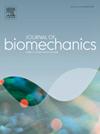Motor variability regulation analysis in trampolinists
IF 2.4
3区 医学
Q3 BIOPHYSICS
引用次数: 0
Abstract
In trampolining, optimizing body orientation during landing reduces injury risk and enhances performance. As trampolinists are subject to motor variability, anticipatory inflight corrections are necessary to regulate their body orientation before landing. We investigated the evolution of a) body orientation and b) limb position (i.e., arms and legs) variabilities. Secondary objectives were to investigate c) the link between acrobatics difficulty and the variability accumulation, and d) to identify links between body orientation variability and gaze orientation. Kinematics and gaze orientation were captured using inertial measurement units and an eye tracker, respectively. Seventeen trampolinists performed up to 13 different acrobatics (different number of rotations in twist and somersault). Intra-trampolinist pelvis orientation and limb position inter-trial variability was computed for each acrobatic at three key timestamps: takeoff, 75 % completion of the twist, and landing. Pelvis orientation variability significantly increased between takeoff and the instant when 75 % of the twist is completed (+75 %) and then decreased from the instant when 75 % of the twist is completed until landing (−39 %). Conversely, limb variability decreased (upper limbs: −66 % and lower limbs: −46 %), before increasing (+357 % and +127 %), suggesting that trampolinists adapted their limb kinematics to regulate pelvis orientation before landing. It was qualitatively observed that this decrease in body orientation variability occurred mostly when trampolinists were looking at the trampoline bed before landing. In addition, there was a moderate correlation between the number of twists in a straight somersault and the variability accumulation at 75 % of the twist, highlighting that trampolinists accumulate more variability as the number of twist rotations increases.
求助全文
约1分钟内获得全文
求助全文
来源期刊

Journal of biomechanics
生物-工程:生物医学
CiteScore
5.10
自引率
4.20%
发文量
345
审稿时长
1 months
期刊介绍:
The Journal of Biomechanics publishes reports of original and substantial findings using the principles of mechanics to explore biological problems. Analytical, as well as experimental papers may be submitted, and the journal accepts original articles, surveys and perspective articles (usually by Editorial invitation only), book reviews and letters to the Editor. The criteria for acceptance of manuscripts include excellence, novelty, significance, clarity, conciseness and interest to the readership.
Papers published in the journal may cover a wide range of topics in biomechanics, including, but not limited to:
-Fundamental Topics - Biomechanics of the musculoskeletal, cardiovascular, and respiratory systems, mechanics of hard and soft tissues, biofluid mechanics, mechanics of prostheses and implant-tissue interfaces, mechanics of cells.
-Cardiovascular and Respiratory Biomechanics - Mechanics of blood-flow, air-flow, mechanics of the soft tissues, flow-tissue or flow-prosthesis interactions.
-Cell Biomechanics - Biomechanic analyses of cells, membranes and sub-cellular structures; the relationship of the mechanical environment to cell and tissue response.
-Dental Biomechanics - Design and analysis of dental tissues and prostheses, mechanics of chewing.
-Functional Tissue Engineering - The role of biomechanical factors in engineered tissue replacements and regenerative medicine.
-Injury Biomechanics - Mechanics of impact and trauma, dynamics of man-machine interaction.
-Molecular Biomechanics - Mechanical analyses of biomolecules.
-Orthopedic Biomechanics - Mechanics of fracture and fracture fixation, mechanics of implants and implant fixation, mechanics of bones and joints, wear of natural and artificial joints.
-Rehabilitation Biomechanics - Analyses of gait, mechanics of prosthetics and orthotics.
-Sports Biomechanics - Mechanical analyses of sports performance.
 求助内容:
求助内容: 应助结果提醒方式:
应助结果提醒方式:


